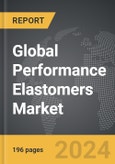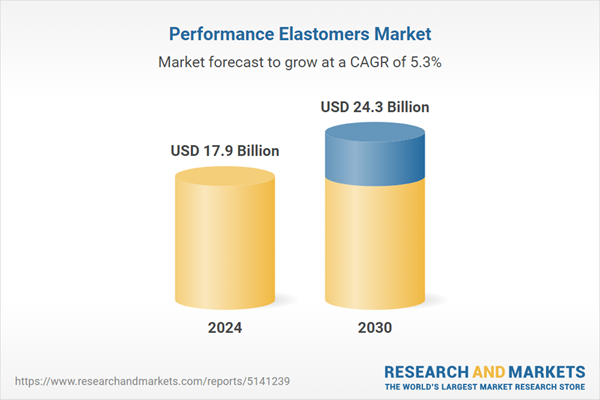The global market for Performance Elastomers was valued at US$17.9 Billion in 2024 and is projected to reach US$24.3 Billion by 2030, growing at a CAGR of 5.3% from 2024 to 2030. This comprehensive report provides an in-depth analysis of market trends, drivers, and forecasts, helping you make informed business decisions. The report includes the most recent global tariff developments and how they impact the Performance Elastomers market.
Segments: Type (Silicone Elastomers, Fluoroelastomers, Nitrile Based Elastomers, Other Types); End-Use (Automotive, Electrical & Electronics, Construction, Industrial Machinery, Other End-Uses).
Geographic Regions/Countries: World; United States; Canada; Japan; China; Europe (France; Germany; Italy; United Kingdom; Spain; Russia; and Rest of Europe); Asia-Pacific (Australia; India; South Korea; and Rest of Asia-Pacific); Latin America (Argentina; Brazil; Mexico; and Rest of Latin America); Middle East (Iran; Israel; Saudi Arabia; United Arab Emirates; and Rest of Middle East); and Africa.
The analysts continuously track trade developments worldwide, drawing insights from leading global economists and over 200 industry and policy institutions, including think tanks, trade organizations, and national economic advisory bodies. This intelligence is integrated into forecasting models to provide timely, data-driven analysis of emerging risks and opportunities.
Global Performance Elastomers Market - Key Trends and Drivers Summarized
Why Are Performance Elastomers Integral to Advanced Manufacturing?
Performance elastomers, a class of high-performance polymers, play a crucial role in modern manufacturing by providing exceptional flexibility, durability, and resilience. These materials are designed to withstand extreme temperatures, harsh chemicals, and significant mechanical stress, making them indispensable in various high-stress applications. In the automotive industry, for instance, performance elastomers are used in seals, gaskets, hoses, and belts due to their superior resistance to heat and wear. Similarly, in the aerospace sector, these materials are essential for components that require high elasticity and toughness under extreme conditions. The unique properties of performance elastomers also make them valuable in the medical field, where they are used in the manufacturing of medical devices and implants that demand biocompatibility and long-term durability. Their ability to maintain integrity under demanding conditions underscores their importance in advanced manufacturing.How Are Technological Advancements Shaping the Future of Performance Elastomers?
The future of performance elastomers is being shaped by continuous technological advancements that enhance their properties and expand their applications. Innovations in polymer chemistry have led to the development of elastomers with improved thermal stability, chemical resistance, and mechanical strength. For example, the incorporation of nanotechnology has enabled the creation of nanocomposite elastomers with superior performance characteristics. Additionally, advancements in additive manufacturing (3D printing) are revolutionizing the production of elastomeric components, allowing for more complex designs and faster production times. The use of computer-aided design (CAD) and simulation tools also facilitates the optimization of elastomer formulations and their performance in specific applications. These technological advancements not only improve the functionality of performance elastomers but also drive their adoption in new and emerging fields, such as wearable technology and advanced robotics.What Applications Showcase the Versatility of Performance Elastomers?
The versatility of performance elastomers is showcased through their wide range of applications across various industries. In the oil and gas sector, these materials are critical for sealing and insulating components that operate under high pressure and temperature. In the electronics industry, performance elastomers are used to protect sensitive electronic components from environmental factors and mechanical damage. The sports and leisure industry also benefits from these materials, as they are used in high-performance athletic footwear, protective gear, and recreational equipment. Moreover, the construction industry relies on performance elastomers for waterproofing, sealing, and vibration damping in building materials and infrastructure projects. The diverse applications of performance elastomers highlight their adaptability and essential role in enhancing product performance and reliability across multiple sectors.What Factors Are Driving the Growth in the Performance Elastomers Market?
The growth in the performance elastomers market is driven by several factors. One significant driver is the increasing demand for durable and high-performance materials in automotive and aerospace industries, where the need for components that can withstand extreme conditions is paramount. Another critical factor is the rise in industrial activities, particularly in emerging economies, which boosts the demand for performance elastomers in machinery and equipment. The ongoing advancements in polymer technology, leading to the development of new and improved elastomer formulations, are also propelling market growth. Additionally, the growing emphasis on sustainability and the development of eco-friendly elastomers from renewable sources are creating new opportunities in the market. The medical and healthcare sectors' demand for high-quality, biocompatible elastomers for medical devices and implants further drives the market. As industries continue to seek materials that offer superior performance and resilience, the performance elastomers market is poised for substantial growth.Report Scope
The report analyzes the Performance Elastomers market, presented in terms of units. The analysis covers the key segments and geographic regions outlined below.Segments: Type (Silicone Elastomers, Fluoroelastomers, Nitrile Based Elastomers, Other Types); End-Use (Automotive, Electrical & Electronics, Construction, Industrial Machinery, Other End-Uses).
Geographic Regions/Countries: World; United States; Canada; Japan; China; Europe (France; Germany; Italy; United Kingdom; Spain; Russia; and Rest of Europe); Asia-Pacific (Australia; India; South Korea; and Rest of Asia-Pacific); Latin America (Argentina; Brazil; Mexico; and Rest of Latin America); Middle East (Iran; Israel; Saudi Arabia; United Arab Emirates; and Rest of Middle East); and Africa.
Key Insights:
- Market Growth: Understand the significant growth trajectory of the Silicone Elastomers segment, which is expected to reach US$15.4 Billion by 2030 with a CAGR of a 6.2%. The Fluoroelastomers segment is also set to grow at 4.4% CAGR over the analysis period.
- Regional Analysis: Gain insights into the U.S. market, valued at $4.7 Billion in 2024, and China, forecasted to grow at an impressive 9.3% CAGR to reach $5.8 Billion by 2030. Discover growth trends in other key regions, including Japan, Canada, Germany, and the Asia-Pacific.
Why You Should Buy This Report:
- Detailed Market Analysis: Access a thorough analysis of the Global Performance Elastomers Market, covering all major geographic regions and market segments.
- Competitive Insights: Get an overview of the competitive landscape, including the market presence of major players across different geographies.
- Future Trends and Drivers: Understand the key trends and drivers shaping the future of the Global Performance Elastomers Market.
- Actionable Insights: Benefit from actionable insights that can help you identify new revenue opportunities and make strategic business decisions.
Key Questions Answered:
- How is the Global Performance Elastomers Market expected to evolve by 2030?
- What are the main drivers and restraints affecting the market?
- Which market segments will grow the most over the forecast period?
- How will market shares for different regions and segments change by 2030?
- Who are the leading players in the market, and what are their prospects?
Report Features:
- Comprehensive Market Data: Independent analysis of annual sales and market forecasts in US$ Million from 2024 to 2030.
- In-Depth Regional Analysis: Detailed insights into key markets, including the U.S., China, Japan, Canada, Europe, Asia-Pacific, Latin America, Middle East, and Africa.
- Company Profiles: Coverage of players such as 3M Company, Arlanxeo Deutschland GmbH, Asahi Glass Co., Ltd., Daikin Industries Ltd., Dow, Inc. and more.
- Complimentary Updates: Receive free report updates for one year to keep you informed of the latest market developments.
Some of the 46 companies featured in this Performance Elastomers market report include:
- 3M Company
- Arlanxeo Deutschland GmbH
- Asahi Glass Co., Ltd.
- Daikin Industries Ltd.
- Dow, Inc.
- DuPont de Nemours, Inc.
- Exxon Mobil Corporation
- Flexan, LLC
- James Walker UK Ltd.
- JSR Corporation
- KACO GmbH + Co. KG
- KRAIBURG TPE GmbH & Co. KG
- Mitsui Chemicals, Inc.
- Momentive Performance Materials, Inc.
- Polycomp B.V.
- Precision Polymer Engineering Ltd.
- Reiss Manufacturing Inc.
- Shin-Etsu Chemical Co., Ltd.
- Showa Denko K.K.
- Solvay SA
- The Chemours Company
- Tosoh Corporation
- Wacker Chemie AG
- Zeon Chemicals L.P
Tariff Impact Analysis: Key Insights for 2025
Global tariff negotiations across 180+ countries are reshaping supply chains, costs, and competitiveness. This report reflects the latest developments as of April 2025 and incorporates forward-looking insights into the market outlook.The analysts continuously track trade developments worldwide, drawing insights from leading global economists and over 200 industry and policy institutions, including think tanks, trade organizations, and national economic advisory bodies. This intelligence is integrated into forecasting models to provide timely, data-driven analysis of emerging risks and opportunities.
What’s Included in This Edition:
- Tariff-adjusted market forecasts by region and segment
- Analysis of cost and supply chain implications by sourcing and trade exposure
- Strategic insights into geographic shifts
Buyers receive a free July 2025 update with:
- Finalized tariff impacts and new trade agreement effects
- Updated projections reflecting global sourcing and cost shifts
- Expanded country-specific coverage across the industry
Table of Contents
I. METHODOLOGYII. EXECUTIVE SUMMARY2. FOCUS ON SELECT PLAYERSIII. MARKET ANALYSISCANADAITALYSPAINRUSSIAREST OF EUROPESOUTH KOREAREST OF ASIA-PACIFICARGENTINABRAZILMEXICOREST OF LATIN AMERICAIRANISRAELSAUDI ARABIAUNITED ARAB EMIRATESREST OF MIDDLE EASTIV. COMPETITION
1. MARKET OVERVIEW
3. MARKET TRENDS & DRIVERS
4. GLOBAL MARKET PERSPECTIVE
UNITED STATES
JAPAN
CHINA
EUROPE
FRANCE
GERMANY
UNITED KINGDOM
ASIA-PACIFIC
AUSTRALIA
INDIA
LATIN AMERICA
MIDDLE EAST
AFRICA
Companies Mentioned (Partial List)
A selection of companies mentioned in this report includes, but is not limited to:
- 3M Company
- Arlanxeo Deutschland GmbH
- Asahi Glass Co., Ltd.
- Daikin Industries Ltd.
- Dow, Inc.
- DuPont de Nemours, Inc.
- Exxon Mobil Corporation
- Flexan, LLC
- James Walker UK Ltd.
- JSR Corporation
- KACO GmbH + Co. KG
- KRAIBURG TPE GmbH & Co. KG
- Mitsui Chemicals, Inc.
- Momentive Performance Materials, Inc.
- Polycomp B.V.
- Precision Polymer Engineering Ltd.
- Reiss Manufacturing Inc.
- Shin-Etsu Chemical Co., Ltd.
- Showa Denko K.K.
- Solvay SA
- The Chemours Company
- Tosoh Corporation
- Wacker Chemie AG
- Zeon Chemicals L.P
Table Information
| Report Attribute | Details |
|---|---|
| No. of Pages | 196 |
| Published | April 2025 |
| Forecast Period | 2024 - 2030 |
| Estimated Market Value ( USD | $ 17.9 Billion |
| Forecasted Market Value ( USD | $ 24.3 Billion |
| Compound Annual Growth Rate | 5.3% |
| Regions Covered | Global |








